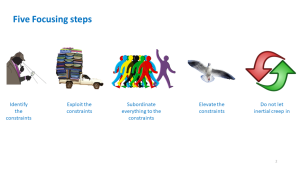12.2 The Five Focusing Steps
In this section, we explore the Five Focusing Steps, a cornerstone methodology of the Theory of Constraints (TOC) designed to systematically improve organizational performance. The essence of this methodology lies in identifying and addressing the most significant limiting factor (referred to as a “constraint”) that stands in the way of achieving a goal. By concentrating efforts on this constraint, businesses can significantly enhance their overall throughput and operational efficiency. The steps are a pragmatic guide to navigating complex systems and making impactful changes where they matter most.
- Identify the Constraint: The starting point in this methodology is to pinpoint the constraint within the process. A constraint is essentially any resource whose capacity is equal to or less than the demand placed upon it. The output capacity of the entire system is, therefore, dictated by this bottleneck. An example can be found in the analogy of a series of pipes with varying diameters; the flow through this system is limited by the pipe with the smallest diameter. Often, a higher Work in Process (WIP) inventory preceding a resource signals its role as a constraint, indicating that the input flow exceeds its processing capacity. Constraints are not always physical; they can also manifest as policies or practices that hinder the system’s ability to meet demand, such as a policy requiring full truckloads for shipping, which might lead to inefficiencies or lost sales.
- Exploit the Constraint: After identifying the constraint, the next step is to maximize its utilization. This involves ensuring a consistent supply of work to the constraint to prevent any downtime and optimizing its operation to reduce inefficiencies, such as minimizing setup times and avoiding disruptions. It’s critical that the constraint only processes work that contributes directly to meeting demand, avoiding waste on low-quality or unnecessary production.
- Subordinate Everything to the Constraint: Once the constraint operates at its maximum capacity, the entire system’s rhythm must adjust to match this pace. This implies slowing down or adjusting other parts of the process to ensure they are in sync with the constraint, preventing the accumulation of excess WIP at other points in the system. This approach challenges the conventional wisdom that seeks to maximize the utilization of all resources, highlighting that only the constraint’s full exploitation directly contributes to increased throughput.
- Elevate the Constraint: If the constraint’s capacity still limits the system despite optimization efforts, the next move is to increase its capacity. This could involve investing in additional resources, implementing process improvements, or finding alternative ways to accomplish necessary tasks. For example, in a healthcare setting where doctors are the constraint, solutions might include hiring more staff or employing technology to streamline patient interactions, thereby elevating the constraint’s capacity.
- Do Not Let Inertia Creep In: The dynamic nature of operations means that once a constraint is resolved, another will inevitably emerge. Therefore, it is essential to continually monitor the system, ready to return to the first step to identify and address new constraints. This cyclical process ensures ongoing improvement and adaptation, fostering a culture of continuous optimization and agility within the organization.

By adhering to these Five Focusing Steps, businesses can navigate the complexities of their operations with clarity and precision, systematically enhancing their capability to meet goals and respond to changing demands.